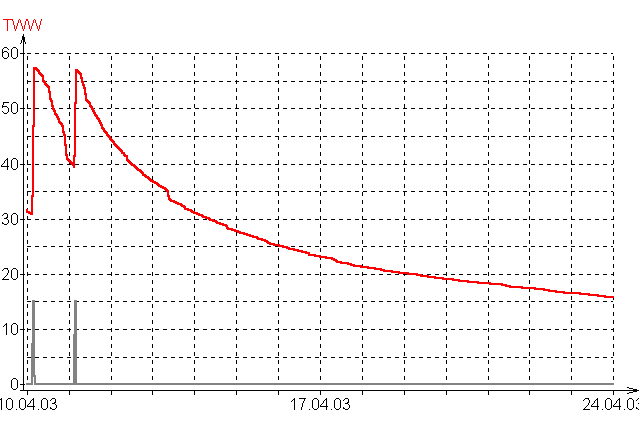Click your way through the heating system data!

Click on the area you are interested in!
In actual operation, the system diagram shows the most important temperatures at one glance.
| Temperatures outside, inside and solar components | | Background information | continue | |

Explanation:
There was a cold spell during these two weeks of December 2002, which send the temperature down from +5ºC to -7ºC. It was cloudy from 6.12. to 9.12., after which the sun was shining for three days. After that, the cloud returned.

Explanation:
March 2003: A long period of high pressure with lots of sunshine
Even though outside temperatures were low, in houses with large windows exposed to the south, it was possible to turn the heating off, because the inside temperature was as high as 25ºC (red line). The sharp rise in outside temperature with cloudless skies was approx. 10K (blue line).
| Temperatures of boiler and heating circuit | | Background information | continue | |

Explanation:
If a cold spell occurs, the controller responds by increasing the temperature of the boiler out-flow, with a simultaneous increase in burner run-time per switch-on.
From 7.12.02 to 12.12.02 we tested the effects of changing the minimum temperature and switch-on differential of the boiler. (Current values: Minimum temperature when operating=55ºC, switch-on differential=12K. The results led us to install a return-flow temperature boost pump to protect the boiler.)
| Inner and consumer temperatures | | Background information | continue | |

Explanation:
The cold spell results in a rise in consumer in-flow and return temperatures. At the same time, we can clearly see how the inside temperature falls much further on the 10.12. (To=-7º) than on the 4.12. (To=+7º). The drop in inside temperature of -3K is very small.
The max. in-flow temperature to the consumer when heating when To=-7º is approx. 38ºC typical for correctly adjusted underfloor heating systems. Boiler output is approx. 10 kW and this by no means uses the capacity of the system to the full.

[Source: Physik in unserer Zeit, 20. Jahrg. 1989, Nr. 4, Erhard Mayer] |
Graph of personal thermal comfortBased on investigations by Fanger, E. Mayer recorded subjective thermal sensitivity at each time of the day. The outcome was that even when the environmental temperature atComparing these graphs with the curves of the inside temperatures we recorded reveals a certain intended similarity :-) |
Heating up fast?
Heating up too rapidly with the result that the office is already at 21░C in the morning ensures only one thing: wasted energy! Air-conditioning systems keeping room temperatures constant ensure a poor office environment and the 'Sick Building Syndrome'. Stale air is normally expelled in private houses in the morning by opening windows - together with the energy used for heating up fast.| Temperatures for hot-water tank with ON-signalisation for charging | | continue | |

Explanation:
With a 300 litres hot-water tank without a circulating pump we only need to charge the tank once per day. This includes supply of hot water to the washing machine and dishwasher. The high hot-water requirement on 21.3.2003 is clearly visible. On the 25.3., only the hot-water tank cool-down is shown.

Explanation:
The cool-down curve of a hot-water tank (unused).
It is generally the case that a fully charged hot-water tank will cool down to 30º after 3 days. According to Buderus, the cooling losses from modern hot-water tanks (this is one!) can be ignored an so they are recharging permanently, although the recommendation of Bosch-Junkers is to charge the hot-water tank prior to using the hot water: we can confirm this! (Bosch took Buderus over in April 2003.)
Still more background information
- Optimization of this heating system in numbers.
- Here you see what servicing the boiler achieves.
- How do you analyse the figures shown for consumption ?
- Technical terms explained.
eMail © System Integration Beitzke
page written 17.8.1999, last change 12:54 29.6.2014, Sonntag
Thanks to the helpers: | Wiesemann und Theis |
page written 17.8.1999, last change 12:54 29.6.2014, Sonntag
Thanks to the helpers: | Wiesemann und Theis |